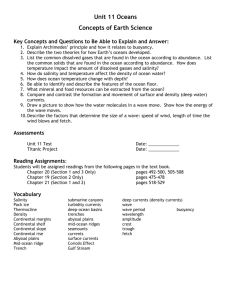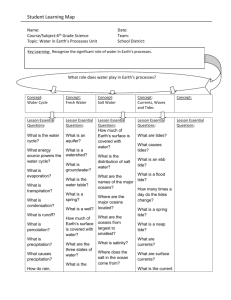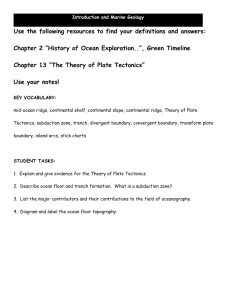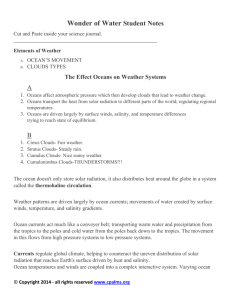Oceanography Test: High School Level
advertisement
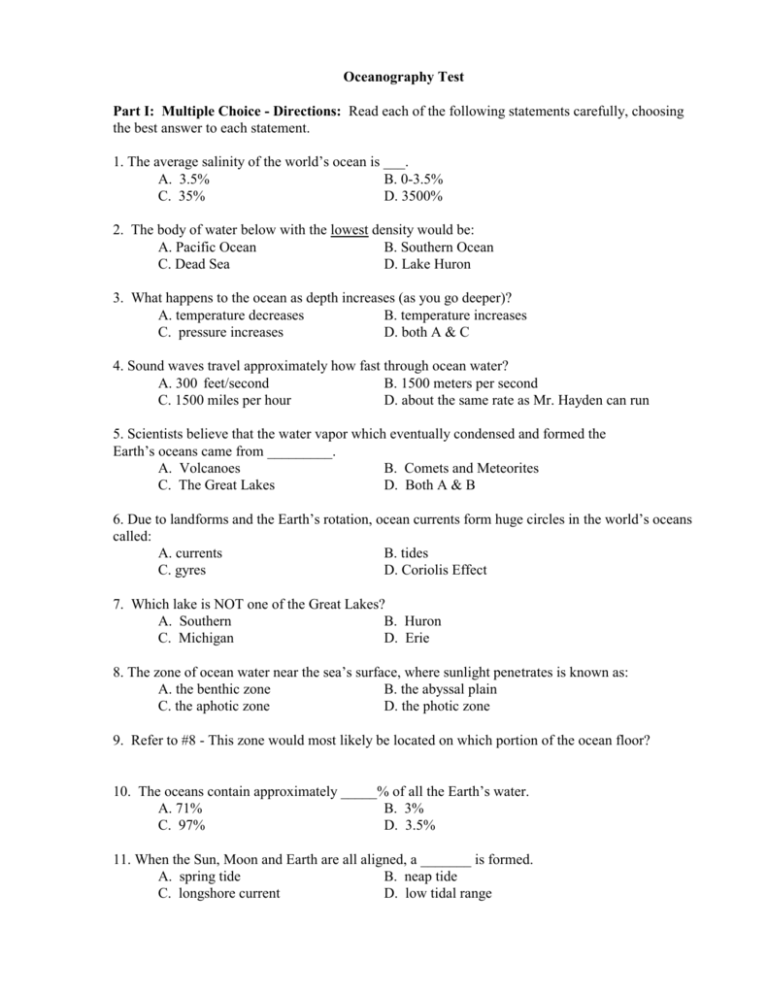
Oceanography Test Part I: Multiple Choice - Directions: Read each of the following statements carefully, choosing the best answer to each statement. 1. The average salinity of the world’s ocean is ___. A. 3.5% B. 0-3.5% C. 35% D. 3500% 2. The body of water below with the lowest density would be: A. Pacific Ocean B. Southern Ocean C. Dead Sea D. Lake Huron 3. What happens to the ocean as depth increases (as you go deeper)? A. temperature decreases B. temperature increases C. pressure increases D. both A & C 4. Sound waves travel approximately how fast through ocean water? A. 300 feet/second B. 1500 meters per second C. 1500 miles per hour D. about the same rate as Mr. Hayden can run 5. Scientists believe that the water vapor which eventually condensed and formed the Earth’s oceans came from _________. A. Volcanoes B. Comets and Meteorites C. The Great Lakes D. Both A & B 6. Due to landforms and the Earth’s rotation, ocean currents form huge circles in the world’s oceans called: A. currents B. tides C. gyres D. Coriolis Effect 7. Which lake is NOT one of the Great Lakes? A. Southern B. Huron C. Michigan D. Erie 8. The zone of ocean water near the sea’s surface, where sunlight penetrates is known as: A. the benthic zone B. the abyssal plain C. the aphotic zone D. the photic zone 9. Refer to #8 - This zone would most likely be located on which portion of the ocean floor? 10. The oceans contain approximately _____% of all the Earth’s water. A. 71% B. 3% C. 97% D. 3.5% 11. When the Sun, Moon and Earth are all aligned, a _______ is formed. A. spring tide B. neap tide C. longshore current D. low tidal range 12. The lowest point on a wave is the wave _______. A. trough B. crest C. wave height D. wavelength 13. The highest point on a wave is the wave _______. A. trough B. crest C. wave height D. wavelength 14. Slow-moving cold ocean currents may rise to the surface. This ________ of cold water carries food particles to the surface, resulting in areas of good fishing. A. upwelling B. crest C. tide D. trough 15. The eastern coast of most continents are _________ due to ocean currents. A. soaked B. warmed C. flooded D. cooled 16. Waters off the western coasts of continents are usually colder because of their _____ origin. A. polar B. tropical C. equatorial D. warm 17. When wind blows across a body of water, _______ between the air and water causes water to move. A. surface currents B. friction C. gravity D. density 18. A ______ is a wave that forms when a rising tide enters a shallow, narrow river sending water rushing inland. A. neap tide B. spring tide C. tidal bore D. rip current 19. A structure that is constructed out in the ocean, parallel to shore, which blocks much of the wave energy from reaching the beach is called a(n): A. groin B. breakwater C. barrier island D. jetty 20. The distance that the wind travels across open water is known as: A. fetch B. gyre C. current D. drift 21. Pollution may enter the oceans as a result of: A. sewage treatment plants B. runoff from farmers’ fields C. shipping D. all of the above 22. Currents in the deep ocean are driven by: A. the wind B. Coriolis Effect C. density differences D. seafloor earthquakes 23. The distance between two crests or two troughs of a wave is called the: A. wavelength B. wave height C. wave period D. wave speed 24. Ships are able to travel between two bodies of water that are at different elevations by using ___________. A. Canals B. Locks C. Elevators D. Currents 25. Oceans cover approximately _____% of earth’s surface. A. 30 B. 50 C. 70 D. 80 26. Surface currents always move water _____________. A. clockwise B. vertically C. counter-clockwise D. horizontally 27. The cool ocean current which flows off the west coast of the United States is called the: A. Gulf Stream B. California current C. Peru current D. Canary current 28. Surface currents are caused by ________________. A. differences in density B. salinity C. waves D. none of these stupid choices are correct! 29. The warm ocean current that flows off the east coast of Africa is called the: A. Brazil B. Benguela C. Peru D. Agulhas 30. Desalination is a process where: A. salt is added to seawater C. salt is taken from freshwater B. freshwater is obtained from seawater D. energy is obtained from seawater Part II: True or False Directions: Read each of the following statements carefully and decide whether each statement is true or false. Please write the entire word on your answer sheet! __________ 31. Coral reefs are found on the abyssal plain. __________ 32. Mid-ocean ridges are formed where one tectonic plate is forced under another. __________ 33. Estuaries have water with a lower salinity than the rest of the ocean. __________ 34. Tides are caused by the gravitational pull from the Sun and moon. __________ 35. Drinking seawater will not keep you alive if you were stranded in the middle of the ocean. __________ 36. The entire ocean has the exact same salinity. __________ 37. Presque Isle sand is entirely black because the sand is formed from black, volcanic rocks. __________ 38. A rocky shoreline is old geologically. __________ 39. The circular patterns of the surface currents are caused by wind. __________ 40. A sea sponge is a producer that makes its own food by using photosynthesis. __________ 41. Surface currents are an example of horizontal movement. __________ 42. Humans often live on volcanic islands called seamounts, such as Hawaii and Iceland. __________ 43. At the beginning of the Earth’s existence, the oceans were very similar to the way they are today in depth, location and salinity. __________ 44. Breakwaters are natural features that slow down longshore erosion. __________ 45. Two of the currents that make up the North Atlantic Gyre are the Brazil and Benguela currents. Name: ___________________ Oceanography Exam - Answer Sheet 1. ________ 16. ________ 31. _____________ 2. ________ 17. ________ 32. _____________ 3. ________ 18. ________ 33. _____________ 4. ________ 19. ________ 34. _____________ 5. ________ 20. ________ 35. _____________ 6. ________ 21. ________ 36. _____________ 7. ________ 22. ________ 37. _____________ 8. ________ 23. ________ 38. _____________ 9. ____________________ 24. ________ 39. _____________ 10. ________ 25. ________ 40. _____________ 11. ________ 26. ________ 41. _____________ 12. ________ 27. ________ 42. _____________ 13. ________ 28. ________ 43. _____________ 14. ________ 29. ________ 44. _____________ 15. ________ 30. ________ 45. _____________ Part III: Short Answer - Directions: Read the followings questions below carefully and respond. 46. Draw and label a neap tide (be sure to show where the tides are!). 47. Draw and label a spring tide (be sure to show where the tides are!). 48. During which of the tides above would the tidal range be lower? 49. We call water near estuaries with a salinity between freshwater and saltwater ____________ water. This water would have a salinity of __________________. 50. What three things determine wave height? 51. Name the three types of ocean organisms, how they generally move, and an example of each. 52. Complete the following chart: Part of Ocean Floor “Zone” How would producers make food? Warm or cold water Shallow Water Deep Water 53. Explain where on Earth you would travel to snorkel above a coral reef, and why the conditions at that specific location would favor coral reef formation. 54. Describe how the direction of ocean gyres differs in the North Pacific and South Pacific. 55. What are the two factors which control the density of seawater? What type of currents are formed by these differences? Are they horizontal or vertical currents? 56. Explain what happens to a wave as it approaches the shore and what will form (3 pts). 57. Clayton has graciously volunteered to walk along the ocean floor from Florida to Africa in the name of Science (Thanks, Clayton!). After being outfitted with oxygen tanks, a pressured, weighted suit/helmet, a flashlight and his teddy bear, Clayton is going to take on this great adventure. Please tell me the parts of the ocean floor in order that he will be traversing on his epic trek (7 points). 58. How could you tell the temperature of an ocean current on an uncolored surface current map? (be specific) 59. Explain how the audience at a sporting event “doing the wave” is similar to a wave travelling in the open ocean.

